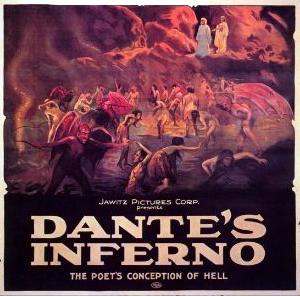 This is a middling silent drama from 1924, of interest because it contains scenes set in a Hell that, as the title promises, is straight out of Dante. This version of DANTE’S INFERNO, directed by the prolific silent-era filmmaker Henry Otto, only exists in incomplete prints running a little over an hour (at least two to three reels short of its initial running time). I doubt that matters much, as nothing herein seems like it would be improved by a longer running time.
This is a middling silent drama from 1924, of interest because it contains scenes set in a Hell that, as the title promises, is straight out of Dante. This version of DANTE’S INFERNO, directed by the prolific silent-era filmmaker Henry Otto, only exists in incomplete prints running a little over an hour (at least two to three reels short of its initial running time). I doubt that matters much, as nothing herein seems like it would be improved by a longer running time.
The film was Hollywood’s answer to the expensive pre-1920 Italian epics inspired by Dante’s INFERNO. At least two such films existed, the most notable of them being the seminal 1911 L’INFERNO. See it instead.
Mortimer Judd is a ruthless slumlord who’s determined to get ahead at all costs. He’s obsessed with Dante’s INFERNO, of which he keeps a hardbound copy on his desk. Judd reads from it and we see the text acted out amid extravagant sets.
We see Dante entering the underworld, where he meets the spirit of the poet Virgil. The latter becomes Dante’s guide through the nine circles of Hell, in which various sinners suffer torments directly tied to their sins on Earth—murderers, for instance, are tossed into a river of blood.
Back in the here-and-now a bunch of Judd’s less moneyed tenants are being evicted. They plead with Judd to have mercy on them, but Judd is too busy with his own problems, which include a demon straight out of the Inferno who makes periodic real-world appearances. The latter warns Judd that if his selfish behavior continues he’ll wind up in Hell just like Dante, and a nightmare in which he Judd is thrown into a molten pit of sinners by the Devil himself seemingly proves just that.
Viewing most surviving silent horror films, the majority of which were made by skilled filmmakers like Fritz Lang, Conrad Veidt and Tod Browning, you might get the wrong idea of the overall quality of such fare. In truth it seems this film, with its vastly simplistic and sentimental narrative, was much closer to the norm. The main character is little more than a construct who changes his mind and nature at the whim of the screenwriters, and exists only to impart a ham-fisted message. There’s even a white guy in blackface (played by the popular comedian Bud Jamison) as the protagonist’s servant, with stereotypical “Uncle Tom” dialogue to match.
As for the inferno sequences, they’re nothing of the sort you can’t see in the 1911 Italian production L’INFERNO. As in that classic, there are dozens of naked extras on display amid superimposed flames and elaborate sets. All this is striking enough, but the overall impact is lessened considerably by presenting the inferno as a dream experienced by the protagonist. It might have been interesting, at least, to put the lead actor in Dante’s place in the inferno sequences, but that would have required more imagination than the filmmakers evidently possessed.
Vital Statistics
DANTE’S INFERNO
Fox Film Corporation
Director: Henry Otto
Screenplay: Edmund Goulding
Cinematography: Joseph August
Cast: Ralph Lewis, Winifred Landis, William Scott, Pauline Starke, Josef Swickard, Gloria Grey, Lorimer Johnston, Lawson Butt, Howard Gaye
